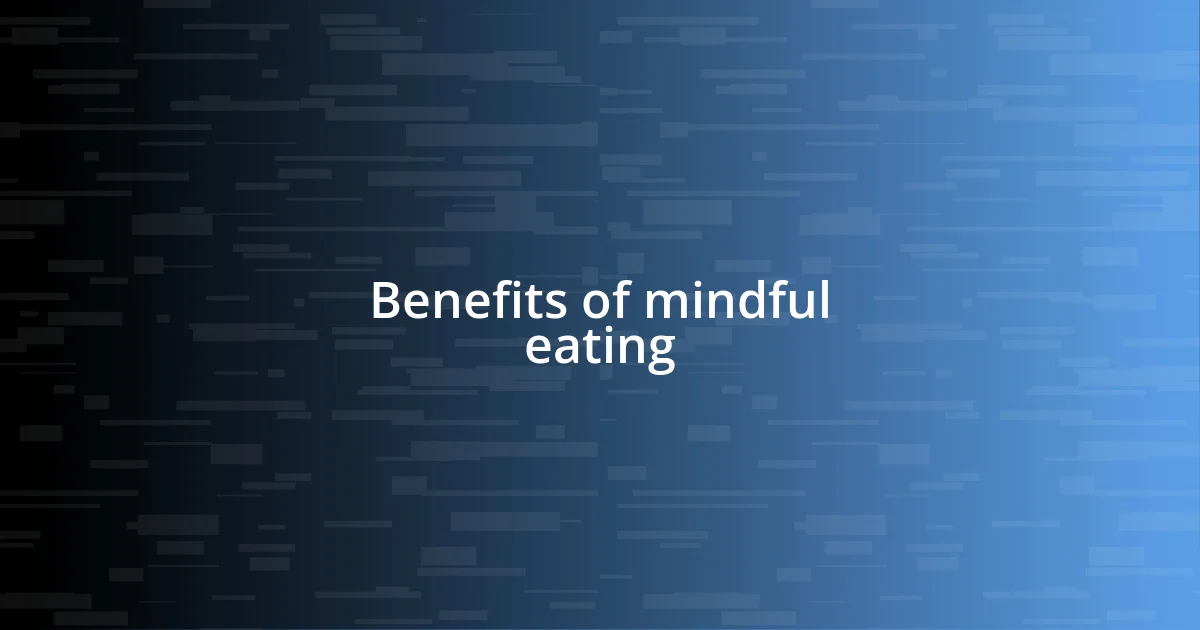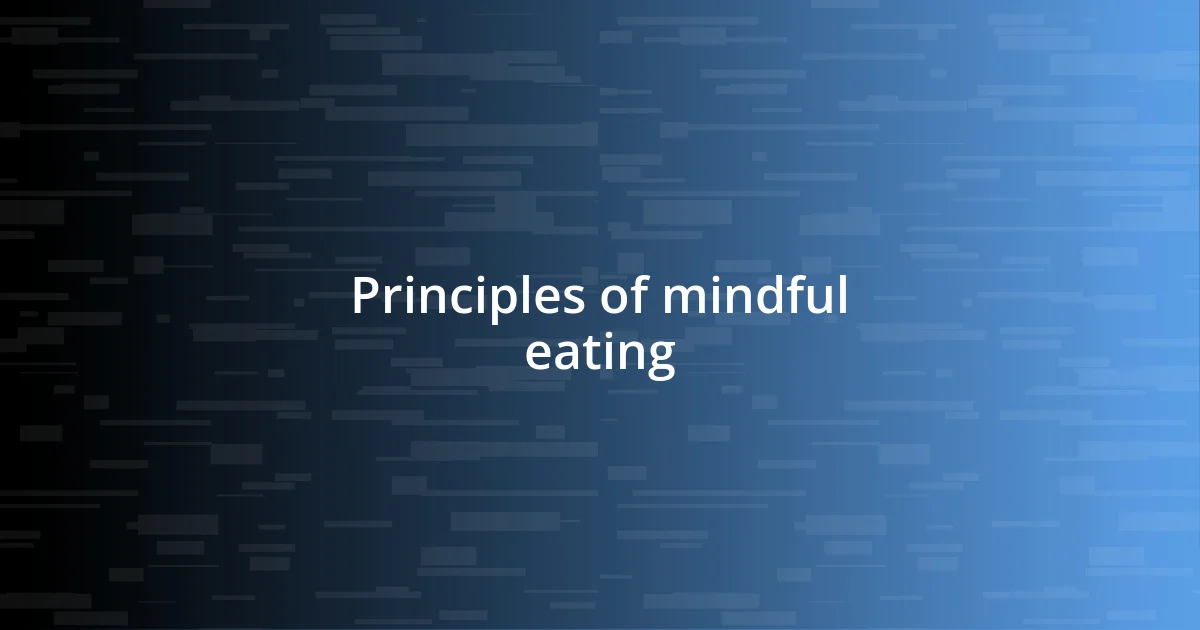Key takeaways:
- Mindful eating enhances the eating experience by promoting awareness of flavors, distinguishing between physical hunger and emotional cravings, and fostering gratitude towards food.
- Key principles of mindful eating include intentionality, non-judgment, mindful portion control, distraction-free eating, and cultivating gratitude for food.
- Techniques such as slowing down, deep breathing before meals, and engaging the senses can help overcome challenges associated with mindful eating, leading to a more enriching meal experience.

Understanding mindful eating
Mindful eating is about being present with your food, allowing yourself to experience every bite fully. I remember sitting down one evening, determined to savor a simple bowl of soup. As I took each spoonful, I noticed flavors and textures I’d previously overlooked in my rush to finish meals.
This practice encourages awareness of not just what we eat, but how we eat. Have you ever paused to consider why you reach for certain foods? I’ve found that my cravings often stem from emotions, rather than hunger, and recognizing that has changed my relationship with food immensely.
By slowing down and tuning into how food affects my mind and body, I’ve discovered a deeper connection to my meals. It’s fascinating how just a moment of stillness can shift your perspective—what if we all took a minute to appreciate our food before devouring it? This simple act can transform eating from a mindless task into a joyful experience.

Benefits of mindful eating
Mindful eating brings a multitude of benefits that extend beyond the plate. One clear advantage I’ve experienced is improved digestion. When I eat slower and pay attention to my food, I notice that I don’t feel bloated anymore. It’s as if giving my body the time to process what I consume truly changes the way I feel afterward. This realization made me appreciate the act of eating even more.
Another significant benefit of mindful eating is the emotional clarity it fosters. I used to eat when I was stressed or bored, often leading to feelings of guilt afterward. By being present during meals, I’ve learned to distinguish between true hunger and emotional eating. Now, when I sit down to eat, I feel a sense of peace that wasn’t there before. I ask myself if I’m really hungry or if I’m just looking for comfort, and this simple question has transformed my snacking habits.
Additionally, I’ve noticed a shift in my overall relationship with food. Mindful eating cultivates a sense of gratitude. When I take the time to appreciate where my food comes from, it deepens my enjoyment. I recall a moment at a farmer’s market, choosing fresh vegetables, and feeling connected to the earth and the effort put into growing those foods. This mindful approach has turned meals into an opportunity for connection, rather than obligation.
| Benefit | Personal Insight |
|---|---|
| Improved Digestion | Savoring food leads to less bloating and discomfort. |
| Emotional Clarity | Distinguishing hunger from emotional triggers reduces guilt. |
| Enhanced Gratitude | Appreciating food fosters connection and enjoyment. |

Principles of mindful eating
Mindful eating revolves around several core principles that can transform how we interact with food. One essential idea is to eat with intention. When I began focusing on why I chose specific foods, I found myself more in tune with what my body truly needed. Intentional choices lead to a more satisfying meal experience, causing me to leave the table feeling nourished and content.
Here are some key principles that define mindful eating:
– Awareness: Be conscious of flavors, textures, and aromas, savoring each bite.
– Non-judgment: Approach your food without guilt or shame; acknowledge cravings as natural.
– Portion Control: Pay attention to hunger and fullness cues—my practice of using smaller plates helped me manage serving sizes.
– Distraction-free Eating: Minimize interruptions, such as screens, allowing full focus on the meal.
– Gratitude: Cultivate appreciation for the food and its origins, as I witnessed firsthand during a farm visit, deepening my connection with what I ate.
Practicing these principles encourages a profound mindfulness that goes beyond the meal itself. An evening spent enjoying a salad transformed into a delightful ritual, where every crunch reverberated in my mind, connecting me to both the food and the moment. By integrating these principles, I’ve turned meals into a meditative practice, revealing layers of enjoyment I never knew I was missing.

Techniques for mindful eating
One of my favorite techniques for mindful eating is to slow down and fully appreciate each bite. I remember during a recent dinner, I took a piece of chocolate cake and before I devoured it, I closed my eyes for a moment. This short pause allowed me to savor the rich flavors, making every mouthful feel like an indulgent experience rather than just a fleeting moment of satisfaction. It made me wonder—how often do we rush through desserts, missing out on the joy?
Another powerful technique I’ve embraced is the practice of deep breathing before meals. Taking a few moments to breathe deeply helps ground me, creating a mental space that encourages mindfulness. I’ve found that simply inhaling and exhaling a few times before digging in helps me clear my mind of distractions. It’s incredible how this simple act cultivates a sense of gratitude and presence, making me appreciate not just the meal, but the act of nourishment itself.
Lastly, I’ve learned to engage my senses fully while eating. I recall one lunch where I decided to notice not just the taste, but also the colors and textures of my salad. Each crunch and vibrant hue told a story, transforming a routine meal into an artistic experience. It left me pondering—why not treat every meal like a celebration of flavors and colors? By embracing this technique, I find each meal becomes a unique experience that enriches my day.

Overcoming challenges in mindful eating
Mindful eating certainly comes with its share of challenges. I remember the first time I tried to eat without distractions; it felt strange to sit at the table alone, away from my phone or the TV. Initially, my mind wandered to everything but my meal—what was on my to-do list, future commitments, even what I could make for dinner tomorrow. I’ve learned that overcoming this tendency requires practice and patience. Now, I relish the quiet moments, allowing my thoughts to settle like a calm lake, making the meal itself the focus.
Another challenge I faced was dealing with emotional eating. There were nights when stress would coax me into the kitchen, searching for comfort in snacks. I started recognizing this pattern and prompted myself to pause before reaching for that bag of chips. Instead, I would ask myself, “Am I truly hungry, or am I looking for solace?” This small question transformed my approach. Often, I would find a quiet corner with a book instead, realizing that emotion drives our choices just as much as hunger does.
Lastly, portion control was a significant hurdle. In my early attempts, I would fill my plate based on habit, not hunger. I vividly remember a meal where I piled on pasta, thinking more was better. Yet, I was left feeling lethargic and unsatisfied. That was a turning point for me—I started experimenting with smaller plates and mindful servings. Now, being intentional about portions helps me appreciate every bite while steering clear of the uncomfortable fullness that once plagued my dining experiences. Isn’t it fascinating how our mindset can shift our relationship with food entirely?

Incorporating mindfulness into meals
Incorporating mindfulness into meals has transformed the way I experience food. One evening, while I was savoring a simple bowl of soup, I decided to put my spoon down between bites. Each pause allowed me to soak in the warmth of the bowl and the aromatic steam rising to my nose. It was a revelation—how often do we overlook the sensory joy wrapped in our food?
I also discovered the power of expressing gratitude before meals. Adopting this practice, I take a moment to appreciate the effort that went into each dish, from the farmers to the cooks. I recall one dinner where I felt overwhelmed by my busy day. Pausing to express gratitude not only elevated my meal but also shifted my mindset. It was like flipping a switch from chaos to calm—what a game changer!
Another technique I’ve found effective is setting the table with intention. Instead of casually throwing down dinner plates, I arrange the setting thoughtfully, which creates a lovely atmosphere. I remember a small gathering I hosted recently; the twinkling candles and neatly arranged utensils transformed the meal into a shared experience. It made me wonder—how can something as simple as presentation amplify our enjoyment? With each careful detail, I felt our conversations deepened, reminding me that the act of eating is often as important as the food itself.














